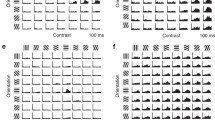Summary
The orientation bandwidth was measured at different spatial frequencies for simple and complex cells. With increasing spatial frequency, the orientation tuning of simple cells became progressively narrower. This tendency was much less marked in complex cells. The results are interpreted in support of geniculate cells with orthogonal orientation biases providing the excitatory and inhibitory inputs to a simple cell.
Similar content being viewed by others
References
Cooper GF, Robson JG (1968) Successive transformations of spatial information in the visual system. IEE NPL Conf Proc 42: 134–143. London: IEE
Daniels JD, Norman JL, Pettigrew JD (1977) Biases for oriented moving bars in lateral geniculate nucleus neurones of normal and stripe-reared cats. Exp Brain Res 29: 155–172
Fairen A, Valverde F (1980) A type of neurone in the visual cortex of cat. A Golgi and electron microscope study of chandelier cells. J Comp Neurol 194: 761–779
Ferster D, Lindström S (1982) An intracellular analysis of geniculo-cortical connectivity in.area 17 of the cat. J Physiol (Lond) 342: 181–215
Hammond P, Andrews DP (1978) Orientation tuning of cells in areas 17 and 18 of the cat's visual cortex. Exp Brain Res 31: 341–351
Heggelund P, Albus K (1978) Response variability and orientation discrimination of single cells in striate cortex of cat, Exp Brain Res 32: 197–211
Henry GH (1977) Receptive field classes of cells in the striate cortex of the cat. Brain Res 113: 1–28
Hubel DH, Wiesel TN (1962) Receptive fields, binocular interaction and functional architecture in the cat's visual cortex. J Physiol (Lond) 160: 106–154
Lee BB, Cleland BG, Creutzfeldt OD (1977) The retinal input to cells in area 17 of the cat's cortex. Exp Brain Res 30: 527–538
Leventhal AG, Hirsch HVB (1978) Receptive-field properties of neurones in different laminae of visual cortex of cat. J Neurophysiol 41: 948–962
Maffei L, Fiorentini A (1973) The visual cortex as a spatial frequency analyser. Vision Res 13: 1255–1267
Morrone MC, Burr DC, Maffei L (1982) Functional implications of cross-orientation inhibition of cortical visual cells. I. Neurophysiological evidence. Proc R Soc Lond B 216: 335–354
Movshon JA, Thompson ID, Tolhurst DJ (1978) Spatial summation in the receptive fields of simple cells in the cat's striate cortex. J Physiol (Lond) 283: 53–77
Phillips GC, Wilson R (1984) Orientation bandwidths of spatial mechanisms measured by masking. J Opt Soc Am A, Series 2, Vol 1: 226–232
Rose D, Blakemore C (1974) An analysis of orientation selectivity in the cat's visual cortex. Exp Brain Res 20: 1–17
Sillito AM (1979) Inhibitory mechanisms influencing complex cell orientation selectivity and their modification at high resting discharge levels. J Physiol (Lond) 289: 33–53
Somogyi P (1977) A specific ‘axo-axonal’ interneurone in the visual cortex of the rat. Brain Res 136: 345–350
Somogyi P, Cowey A (1981) Combined Golgi and electron microscopic study of the synapses formed by double bouquet cells in the visual cortex of the cat and monkey. J Comp Neurol 195: 547–566
Tolhurst DJ, Thompson ID (1981) On the variety of spatial frequency selectivities shown by neurones in area 17 of the cat. Proc R Soc Lond B 213: 183–199
Vidyasagar TR (1984) Geniculate orientation biases as Cartesian co-ordinates for cortical orientation detectors. In: Rose D, Dobson V (eds) Models of the visual cortex. John Wiley and Sons, New York (in press)
Vidyasagar TR, Heide W (1984) Geniculate orientation biases seen with moving sine wave gratings: implications for a model of simple cell afferent connectivity. Exp Brain Res 57: 196–200
Vidyasagar TR, Urbas JV (1982) Orientation sensitivity of cat LGN neurones with and without inputs from visual cortical areas 17 and 18. Exp Brain Res 46: 157–169
Author information
Authors and Affiliations
Rights and permissions
About this article
Cite this article
Vidyasagar, T.R., Sigüenza, J.A. Relationship between orientation tuning and spatial frequency in neurones of cat area 17. Exp Brain Res 57, 628–631 (1985). https://doi.org/10.1007/BF00237851
Received:
Accepted:
Issue Date:
DOI: https://doi.org/10.1007/BF00237851




